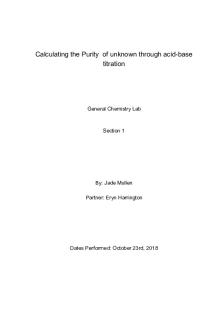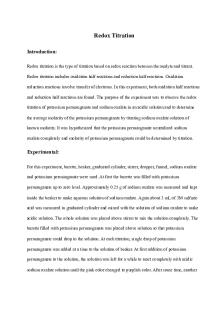Titration Worksheet - Lab Report PDF

| Title | Titration Worksheet - Lab Report |
|---|---|
| Course | General Chemistry |
| Institution | Concordia University Wisconsin |
| Pages | 2 |
| File Size | 92.2 KB |
| File Type | |
| Total Downloads | 14 |
| Total Views | 141 |
Summary
Lab Report...
Description
Titration of a Strong Acid Worksheet Names: Day and Time of Lab: Thursday at 01:00pm to 03:00pm Date experiment performed: 4 March 2021 Data and results: Trial number Initial Volume Final Volume Total Volume NaOH [mL] NaOH [mL] NaOH [mL] 1 2 3
0.00 0.00 0.00
9.80 9.91 9.90
9.80 9.91 9.90
[HCl] dilute [mol/L] 0.0204 0.0206 0.0206
[HCl] original [mol/L] 0.204 0.206 0.206
Average HCl concentration of the original solution: 0.205 M Example Calculations: 1. Calculate the concentration of the HCl in the diluted sample . 9. 80𝑚𝐿 𝑁𝑎𝑂𝐻 ×
1𝐿 1000𝑚𝐿
0. 000510𝑚𝑜𝑙 𝑂𝐻 × 0.000510𝑚𝑜𝑙 0.025𝐿
×
0.051998𝑚𝑜𝑙 𝑁𝑎𝑂𝐻 1𝐿
1 𝑚𝑜𝑙 𝐻𝐶𝐿 1𝑚𝑜𝑙 𝑂𝐻
×
1𝑚𝑜𝑙 𝑂𝐻 1 𝑚𝑜𝑙 𝑁𝑎𝑂𝐻
= 0. 000510𝑚𝑜𝑙 𝑂𝐻
= 0. 000510𝑚𝑜𝑙 𝐻𝐶𝐿
= 0. 0204𝑀 𝐻𝐶𝐿 𝑑𝑖𝑙𝑢𝑡𝑒
2. Calculate the concentration of the HCl in the original sample
9. 80𝑚𝐿 𝑁𝑎𝑂𝐻 ×
1𝐿 1000𝑚𝐿
0. 000510𝑚𝑜𝑙 𝑂𝐻 ×
×
0.051998𝑚𝑜𝑙 𝑁𝑎𝑂𝐻 1𝐿
1 𝑚𝑜𝑙 𝐻𝐶𝐿 1 𝑚𝑜𝑙 𝑂𝐻
×
1 𝑚𝑜𝑙 𝑂𝐻 1 𝑚𝑜𝑙 𝑁𝑎𝑂𝐻
= 0. 000510𝑚𝑜𝑙 𝑂𝐻
= 0. 000510𝑚𝑜𝑙 𝐻𝐶𝐿
0. 0204𝑀 × 0. 100𝐿 = 𝑀 × 0. 0100𝐿 = 0. 204 𝑀
Discussion Questions: 1. How many significant figures should your average [HCl] contain? Explain.
The average [HCl] should contain 3 significant figures because the number recorded after subtracting the burette and volumetric pipet was to the hundredths place, leaving the total amount of significant figures to be 3. 2. If you collected the NaOH in a wet beaker, how would that affect the measured concentration of HCl? If the NaOH is collected in a wet beaker, that will decrease the molarity of NaOH. The decrease in molarity will affect the concentration to be different, leading to an inaccurate initial concentration. 3. A student achieves a very faint pink color at the endpoint of a titration. After letting the titrated solution sit on the lab bench while working on the next titration, the student notices that the solution turned back to being clear with no faint pink color. Give two reasons why this may have happened. One of the reasons why this may have happened could be the reaction shifting back to equilibrium. This is due to equilibrium being dynamic and continuous. Another possible reason could be that the reaction occurred in an open container. The open container could have let the chemicals evaporate, shifting the reaction back to equilibrium. 4. Getting ready to perform a titration, a student adds two drops of phenolphthalein to their solution in the Erlenmeyer flask. The solution immediately turns a dark pink color. What is the most likely reason for this observation? The Erlenmeyer flask used to perform a titration could not have been washed properly from the previous titration performance. The residue of NaOH left in the Erlenmeyer flask could have been indicated by the pink colored indicator....
Similar Free PDFs

Titration Worksheet - Lab Report
- 2 Pages

Lab Report titration curve
- 7 Pages

Back titration - chem lab report
- 2 Pages

Acid base titration lab report
- 5 Pages

Acid-Base Titration Lab Report
- 7 Pages

Chemistry Report Titration 1
- 5 Pages
Popular Institutions
- Tinajero National High School - Annex
- Politeknik Caltex Riau
- Yokohama City University
- SGT University
- University of Al-Qadisiyah
- Divine Word College of Vigan
- Techniek College Rotterdam
- Universidade de Santiago
- Universiti Teknologi MARA Cawangan Johor Kampus Pasir Gudang
- Poltekkes Kemenkes Yogyakarta
- Baguio City National High School
- Colegio san marcos
- preparatoria uno
- Centro de Bachillerato Tecnológico Industrial y de Servicios No. 107
- Dalian Maritime University
- Quang Trung Secondary School
- Colegio Tecnológico en Informática
- Corporación Regional de Educación Superior
- Grupo CEDVA
- Dar Al Uloom University
- Centro de Estudios Preuniversitarios de la Universidad Nacional de Ingeniería
- 上智大学
- Aakash International School, Nuna Majara
- San Felipe Neri Catholic School
- Kang Chiao International School - New Taipei City
- Misamis Occidental National High School
- Institución Educativa Escuela Normal Juan Ladrilleros
- Kolehiyo ng Pantukan
- Batanes State College
- Instituto Continental
- Sekolah Menengah Kejuruan Kesehatan Kaltara (Tarakan)
- Colegio de La Inmaculada Concepcion - Cebu









